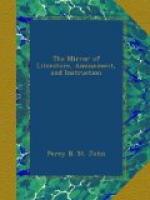We know no one who has been more cruelly misrepresented than the subject of this notice. In reality a person of the gentlest and most inoffensive habits, he is any thing rather than the desperate ruffian he has been described. In his demeanour he is modest and unassuming; in his disposition, liberal and generous to a fault. Like most artists, ardent and enthusiastic in his temperament, and in his actions very much a creature of impulse; he is full of that unaffected simplicity which we almost invariably find associated with true genius. He has an only son, by a Signora Antonia Bianchi, a singer from Palermo, with whom he lived for several years until the summer of 1828, when he was under the necessity of separating from her in consequence of the extreme violence of her temper; and in this little boy all his affections are concentrated. He is a very precocious child, and already indicates strong signs of musical talent. Being of a delicate frame of health, Paganini never can bear to trust him out of his sight. “If I were to lose him,” says he, “I would be lost myself; it is quite impossible I can ever separate myself from him; when I awake in the night, he is my first thought.”—Accordingly, ever since he parted from his mother, he has himself enacted the part of the child’s nurse.
* * * * *
Why is Mr. Whitbread in his brewery like the Jerusalem coffee-house? Because He-brews drink therein.
W.G.C.
* * * * *
THE NATURALIST.
* * * * *
THE SUSTILLO.
A caterpillar, which the Indians name sustillo, and by which a paper is fabricated, very similar to that made in China, is bred in the pacae, a tree well known in Peru. In proportion to the vigour and majestic growth of this tree, is the number of the insects it nourishes, and which are of the kind and size of the bombyx, or silk-worm. When they are completely satiated, they unite at the body of the tree, seeking the part which is best adapted to the extension they have to take. They then form, with the greatest symmetry and regularity, a web which is larger or smaller, according to the number of the operators; and more or less pliant, according to the quality of the leaf by which they have been nourished, the whole of them remaining beneath. This envelope, on which they bestow such a texture, consistency, and lustre, that it cannot be decomposed by any practicable expedient, having been finished, they all of them unite, and ranging themselves in vertical and even files, form in the centre a perfect square. Being thus disposed, each of them makes its cocoon, or pod, of a coarse and short silk, in which it is transformed from the grub into the chrysalis, and from the chrysalis into the papilio, or moth. In proportion as they afterwards quit their confinement, to take wing, they detach wherever it is most convenient to them, their envelope, or web, a portion of which remains suspended to the trunk of the tree, where it waves to and fro like a streamer, and which becomes more or less white, according as the air and humidity of the season and situation admit. This natural silk paper has been gathered measuring a yard and a half, of an elliptical shape, which is peculiar to all of it.




